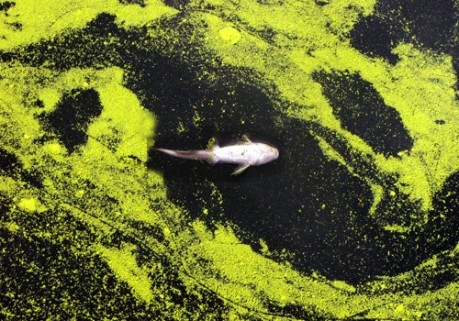Eutrophication… What is it? What does it cause? What can we do?
- Eutrophication is a process caused by an influx of nutrients into aquatic ecosystems; it results in an overgrowth of algae which has detrimental effects on other plants and animals. Eutrophication is something I believe not enough people know about… and they should as it’s our human activities that are speeding up the process and enabling it to affect more and more areas. Agriculture is the main contributor to eutrophication; the fertilizers, pesticides and other chemicals used in farming contains nitrates and phosphates which run off land into rivers and streams then eventually reach lakes and the sea, which causes eutrophication to take place. Industrial activity and sewage disposal also adds to the problem.
- What you are seeing here is a toxic algal bloom, this is a result of eutrophication!

Algae feed on the nutrients, flourishing and killing other species. Algal blooms prevent sunlight from reaching other plants which stops photosynthesis and results in a lack of oxygen in the water. Not to mention the harmful toxins being released by the blooms. However, it is not only animals and plants being affected by eutrophication – the consequences also affect us as these toxic algal blooms are also extremely harmful to our health if on our skin or ingested.
Our fisheries and public water systems are something we rely on. They are both financially affected by eutrophication…
So surely it is in our best interest to prevent it?
- There are a few methods that could be used to reduce eutrophication and its effects such as; wastewater treatment, maintenance of flood plains and riparian buffers.
– Further treating of our wastewater would certainly decrease the anthropogenic waste that is being pumped into rives, lakes and seas.
– Maintaining flat plains along the side of rivers can also help to reduce the nutrient load, when the water rises and the river floods the nutrient rich sediment will be deposited onto the plains and not into aquatic ecosystems.
-Riparian buffers are large areas of vegetation between a river and agricultural land, preventing run off and decreasing the input of nutrients into the river.
These are methods would be effective and are relatively simple. If we have the ability to prevent eutrophication, do a little to save the environment and help ourselves along the way…Why don’t we?
Of course these methods will not be cheap but it’s a small price to pay in the long run. These were only a few methods – there must be more out there!
Kathini

really made me think about the pollution that i made
LikeLiked by 1 person
Pingback: Marine Pollution – Is It All Just Plastic? – Wave pollution goodbye…
Pingback: Eutrophication, ending it at home: – Wave pollution goodbye…
Pingback: What are algal blooms? And what do they have to do with climate change? – Wave pollution goodbye…